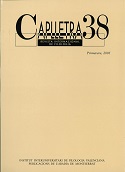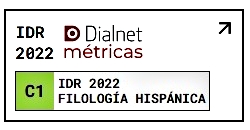Construcciones con avance estilístico en el catalán antiguo
DOI:
https://doi.org/10.7203/caplletra.38.4876Palabras clave:
construccions, català antic Resumen
Resumen
Stylistic Fronting is a phenomenon that has been intensively studied with respect to the symmetric Germanic Verb Second languages: Old/Modern Icelandic, Old/Modern Faeroese but also Middle English and Modern Yiddish. Standardly Stylistic Fronting is seen as an operation that moves an element in front of the finite verb in order to rescue the verb second constraint, in sentences that contain a subject gap. With the claim that the Old Romance languages are symmetric verb second languages, it soon followed that inverted elements in embedded contexts were analysed analogously to the Germanic inverted elements, i.e. as displaying Stylistic Fronting (Cardinaletti & Roberts 1991, Fontana 1993). In this paper I will present examples that show an nearly identical case of inversion in Old Catalan; nearly identical, because
in Old Catalan there are examples with stylistically fronted elements that don’t obey one of the formulated constraints of Stylistic Fronting: they appear next to a full subject. Furthermore, we find an interesting interplay between Stylistic Fronting and enclitic pronouns: not only that they disappear exactly at the same time in the history of Catalan, they also exclude each other during the time they were possible in Old Catalan. In this paper I hope to show that contrary to recent opinions Stylistic Fronting in Old Romance does have an effect on the information structure of the sentence comparable to the effect that topicalisation has on the information structural interpretation.
 Descargas
Descargas
Descargas
Publicado
Cómo citar
-
Resumen414
-
PDF (Català)167
Número
Sección
Licencia
El autor o autora que dirija un trabajo a la redacción de Caplletra para ser publicado tiene que ser la persona titular legítima de los derechos de explotación. La legitimación para la publicación del trabajo tiene que incluir también las imágenes, las tablas, los gráficos y otros materiales que puedan complementar el texto, con independencia de si es su autor o autora.
Copyright. Al publicar el trabajo en la revista, el autor o autora cede a Caplletra. Revista Internacional de Filologia los derechos de explotación (reproducción, distribución y comunicación pública), tanto para la edición impresa en papel como para la versión electrónica.
Todos los trabajos publicados en Caplletra se encuentran bajo una licencia Creative Commons del tipo Reconocimiento-NoComercial-SinObraDerivada 4.0.
RESPONSABILIDAD
Caplletra. Revista Internacional de Filologia no se identifica necesariamente con los puntos de vista sostenidos en los trabajos que publica.Caplletra. Revista Internacional de Filologia declina toda responsabilidad derivada de cualquier vulneración eventual de los derechos de propiedad intelectual que pudiera ser llevada a cabo por los autores o autoras.






